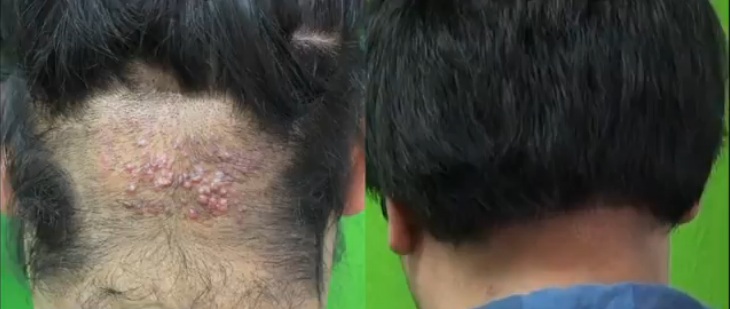The exact causes of Acne Keloidalis Nuchae are unclear. AKN is a form of folliculitis where the hair follicles become inflamed. This inflammation may be due to the immune system overreacting to hair shafts that grow back into the skin. Or the inflammation may happen if the hair follicles are infected with bacteria, fungi or viruses.
A study published in Plastic Reconstructive Surgery (1997) found high levels of testosterone in the keloid scars. So testosterone may contribute to the formation of AKN scars.
Close shaving of the hair on the back of the head, irritation of the skin from collars or sporting gear are possible initiators. Also some patients have visited barbershops where the equipment is not properly sterilized. This introduces the risk of infection. However these events are common in everyday life. Because the incident rates of AKN are relatively low across the age and ethnic groups at risk, there is probably a genetic predisposition for the condition.
Bumps on the back of your head may or may not be indications of early onset Acne Keloidalis Nuchae. There are different forms of folliculitis, such as barber’s itch and hot tub folliculitis. Sometimes superficial forms of folliculitis can go away without any treatment.
Typically in the early stages of AKN, the bumps are white and filled with pus. Also there are red pea sized bumps present as well. Often this skin feels itchy, tender and may bleed. Try to avoid scratching as much as possible and wash this area on a daily basis. Choose clothing that does not irritate the skin. Most importantly, speak to your dermatologist to start a treating the condition from progressing to more advanced phases.
Usually males of African descent are at risk for AKN. However the condition has also been seen in Latino and Asian males. The condition starts between the ages of 13-25 and persists up to the about 50.
Oral medications can help alleviate the symptoms in the early phases only. A doctor will usually prescribe antibiotics (e.g. clindamycin or rifampicin) when the inflammation is perpetuated by bacteria and other microbes in the hair follicles.
Cortisone is simply a type of steroid. Both work to reduce inflammation by constricting your blood vessels.
Inflammation occurs to protect the body from foreign invaders that are not supposed to be present (e.g. bacteria, toxins, protein etc.). Specialized white blood cells basically attack the invaders.
Constricting the blood vessels basically tones down the intensity of this process.
The inflammation of AKN is caused by bacteria or the presence of the hair shaft. The body’s reaction to these antigens is quite extreme, so the cortisone and steroid creams work to minimize the intensity of the process.
Prescription strength cortisone and steroids simply help to minimize the itching and other forms of discomfort experienced during the beginning stages of AKN. They can be administered topically as creams.
When the condition advances to scar-like papules, corticosteroids can be injected into the lesions (intralesional injections) to reduce swelling.
For more severe stages of AKN, prednisone (which is a corticosteroid) is injected into the lesions. The drug works with cellular processes that suppress immune activity.
They do not get rid of the overall condition.
Retinoid is a vitamin A derivative. It works at the dermal layer beneath the skin’s surface to promote the formation and turnover of normal skin cells, which is helpful to some extent with AKN, where the formation of abnormal skin tissue is an issue.
Lasers can work in one of two ways. They can remove the problematic hair shafts causing the inflammation. Since lasers modulate tissue, they can break up the scar tissue and shrink the size of the papules.
Surgery is the only way to clear the scars and tumor like masses that develop in the advanced stages of Acne Keloidalis Nuchae. Basically this area of tissue is removed through excision.

